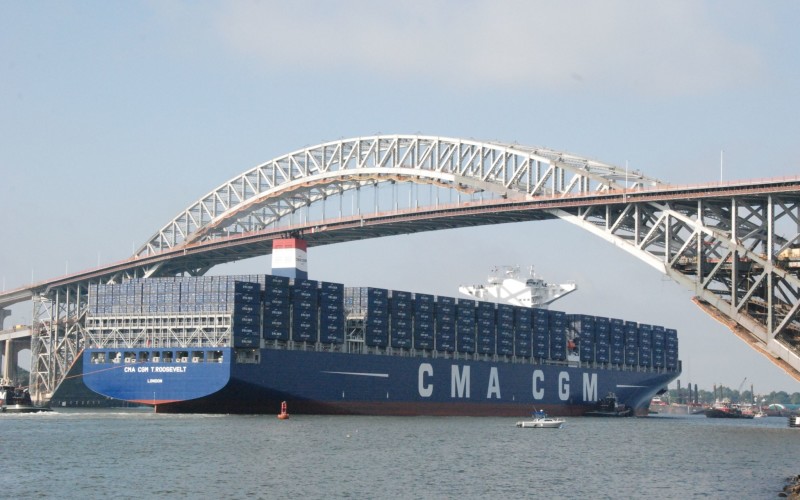The catastrophic ship allision and collapse of the Francis Scott Key Bridge on March 26 is bringing new scrutiny of safety and ship assist requirements for large container vessels calling at increasingly busy U.S. ports.
The 984’x157’ Dali was outbound from Baltimore to Colombo, Sri Lanka, with 21 crew and two pilots on board when the allision happened around 1:29 a.m. Video of the ship’s approach and impact showed the Dali’s lights going dark minutes before impact, coming on and darkening again as black smoke plumed from the ship’s stack.
The images led mariners and news media alike to suggest the Dali suffered a sudden power failure and the crew was struggling to recover control. The ship, traveling at 8 knots, veered slowly to starboard, striking a main pier of the Key Bridge and collapsing the span – sending a crew of six contractor workmen falling into the Patapsco River, Maryland officials said.
A mayday call from the Dali pilots alerted the Maryland Department of Transportation just in time—around 90 seconds—for Maryland Transportation Authority police to start stopping traffic on the bridge approaches and saving lives, said Gov. Wes Moore. But on the video, flashing yellow lights could still be seen on the road crew’s vehicles just before the bridge deck plummeted.
“You never thought you would physically see the Key Bridge tumble down,” Baltimore Mayor Brandon M. Scott said in a press conference after daybreak that Tuesday morning. “It looked like something from an action movie.”
The sudden loss of power, affecting steering and propulsion, came at a critical moment. Photos of the Dali showing its port side anchor chain paid out, and the burst of exhaust smoke shown on the allision video suggest the pilots and crew were attempting to back down and arrest the vessel.
A day after the disaster, National Transportation Safety Board investigators were back on board with Dali, examining the vessel’s data recorders and interviewing crew. The sequence of their departure from the Dundalk terminal and progress toward the bridge is critical to the NTSB’s work.
One minute later multiple alarms began to sound on the bridge, and the ship went into complete blackout. At 1:26:39 a.m. the lead pilot called help from tugs, and the Eric McAllister turned back to head for the emergency. Despite backing, turning hard left and dropping the port anchor, the Dali crashed into the bridge pier at 1:29 a.m.
With 1,100’ horizontal clearance and 185’ vertical, the gap under the main span of the 1.6-mile Key bridge has afforded wide goalposts for mariners since it was completed in 1977. But since then, the shipping industry has transitioned to much larger container vessels over four decades, and any allision from a nearly 1,000’ vessel would likely endanger even more modern structures, U.S. Secretary of Transportation Peter Buttigieg said.
The bridge collapse bottled up other cargo vessels berthed at Baltimore and four vessels of the U.S. Maritime Administration (Marad) designated for use in national emergencies. With an expected timeline of weeks to clear the channel, the Baltimore lockdown showed the vulnerability of infrastructure in increasingly crowded and busy East Coast ports.
In the Port of New York and New Jersey, worries about vulnerability—and being outraced by competing ports—led in 2017 to rebuilding the Bayonne Bridge over the Kill Van Kull, a narrow channel from New York Harbor proper into Newark Bay and the New Jersey container terminals.
That $1.7 billion bridge project lifted the bridge deck’s air clearance from 151’ to 215’ above the water to accommodate the new generation of ships carrying up to 18,000 containers. With a center span almost 1,700’ the Bayonne Bridge is as impressive as the Key Bridge was – all the more so when a ship is moving under it, against an outgoing tide, with tugs in close attendance.
Unlike the Key Bridge, the Bayonne span foundations are on shore, not in the water. But even a lesser accident shutting the Kill Van Kull could cripple port operations until the channel is cleared.
Then a new April 5 incident in New York Harbor made that plain.
The 1,145’x150’, 89,000-ton APL Qingdao was outbound Friday from Port Newark, passing through the Kill Van Kull channel to head south for the bridge when the crew reported a loss of propulsion around 8:30 p.m. to the Coast Guard Vessel Traffic Service, according to a statement from Coast Guard Sector New York.
“The vessel regained propulsion and was assisted to safely anchor in Stapleton Anchorage, outside of the navigable channel just north of the Verrazano Bridge, by three towing vessels,” according to the Coast Guard sector public affairs office in New York. “These towing vessels were escorting the vessel as a routine safety measure, which is a common practice for large vessels departing their berth.”





